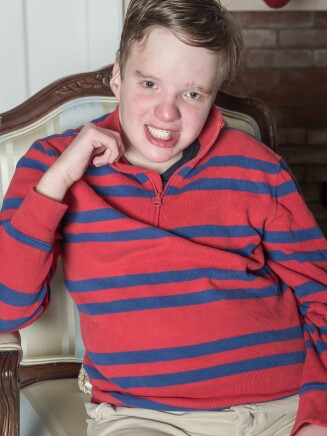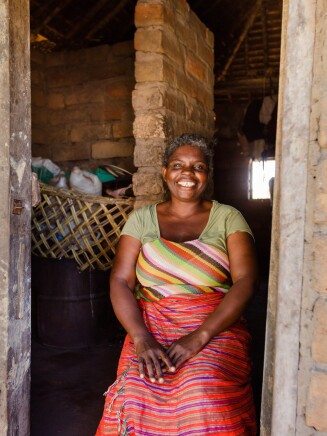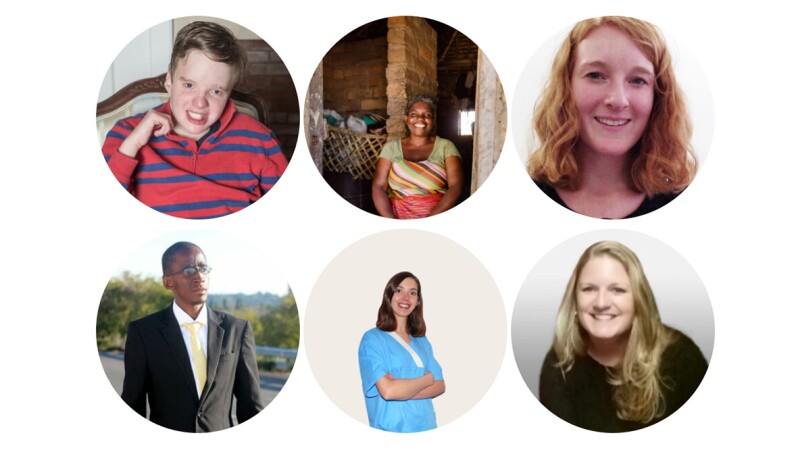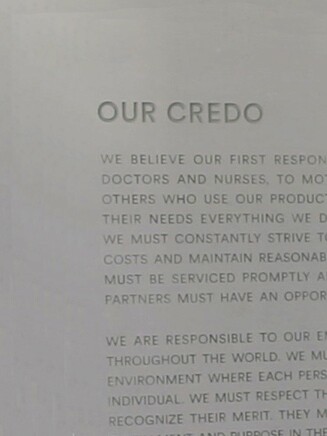A spinal implant that gave a young boy a chance at a normal life. Medication that helped make living—and thriving—with HIV possible. Surgery that helped alleviate the shame and pain that came with a childbirth injury.
While it may seem like these stories are unrelated, they have one important uniting theme: Johnson & Johnson helped pave the way for these patients across the globe to triumph over adversity.
Putting patients first is at the heart of Johnson & Johnson’s ethos, and at the forefront of Our Credo, the company’s guiding mission statement written 75 years ago, which states in its very first paragraph that “in meeting [patients’] needs everything we do must be of high quality.”
To highlight how deeply committed Johnson & Johnson is to the men, women and children around the world who rely on its treatments, medical devices and other lifesaving programs and products, we’re sharing six exceptional and inspirational patient stories.
Hope in the form of a spinal implant
“We already knew that he had many significant medical complications,” Charles says. Chief among them: scoliosis. “He had an extreme curvature of the spine,” Charles adds. And it needed to be fixed in the next few years so that his lungs could develop.
For much of the first two years of his life, Matthew couldn’t sit up, crawl or walk or talk. He spit up his food and had to be fed through a tube. It was devastating for his parents to watch.
“Meghan and I were processing all these emotions, mostly sadness and fear,” Charles says. “But we also knew we had to act.”
A turning point came when the Houders met Dr. Robert Campbell, an orthopedic surgeon and then-director of the Center for Thoracic Insufficiency Syndrome at Children’s Hospital of Philadelphia.
Dr. Campbell, who specialized in treating children with spinal deformities, drew on a piece of paper his plan for Matthew: build an internal scaffolding to create the space the boy’s curved spine couldn’t currently provide.
Dr. Campbell was describing the DePuy Synthes device that he had actually invented in the late 1980s: the VEPTR® Vertical Expandable Prosthetic Titanium Rib, a curved metal rod that is surgically attached to a pediatric patient’s rib, spine or pelvis, using hooks on both ends. It expands to help straighten the spine and separate ribs so that a child’s lungs have room to grow as he does.
In the spring of 2010, Matthew, not quite 4, was strong enough for his first VEPTR Device surgery. “It was a difficult, five-hour operation, and the recovery was as tough as it gets,” Charles recalls.
After 10 days in the hospital, Matthew came home and he still couldn’t walk, and had trouble sitting up and eating.
But Dr. Campbell insisted: “Don’t lose faith.”
The words were prophetic. Following a second surgery in 2010 to expand the VEPTR Device, “Matthew began an upward trajectory that hasn’t stopped,” Meghan says. Matthew began to walk. To keep formula down. To go on family trips.
The boy, now 12, has since undergone 25 VEPTR Device surgeries to keep the expansion apace with his growth. Since Dr. Campbell’s death in July 2018, his proteges have taken over Matthew’s care without missing a beat.
Although Matthew can’t talk due to low muscle tone (he communicates with an Apple device), he is a fun brother to his three siblings, and a lover of chocolate milk, YouTube videos and cars.
And he has a family that is deeply dedicated to caring for him.
“We are so grateful to have that family love,” Charles says. “And we were so lucky to have Dr. Campbell in Matthew’s life. In our years working with him, he always looked not merely at the patient, but at the whole family.”

A life-changing fistula surgery
She was experiencing prolonged labor, and the baby failed to descend. It was very hard to get from her rural village in Zambia to a medical center, and when she finally did reach the hospital, Jenipher was in extreme pain.
There, a double tragedy occurred. Jenipher’s baby was stillborn, and she was afflicted with obstetric fistula, an opening between a woman’s genital tract and the urinary tract or rectum, caused by birth trauma.
The condition is often the result of long, unattended labor, when the baby’s head pushes against the mother’s pelvic bone, causing a lack of blood flow that then leads to the death of tissue. The result: chronic incontinence, including a foul smell.
Due to her condition, Jenipher was shamed within her community, and her husband abandoned her. “I had to cut small pieces of cloth from old blankets to use as protective clothing, and I changed clothes regularly,” she says. “I never went to public gatherings.”
Jenipher’s condition occurs most often in resource-poor settings, like sub-Saharan Africa or Southeast Asia, where timely access to obstetric care can be limited. To help provide relief, the Fistula Foundation, a not-for-profit organization that funds repair surgeries, has been making strides in helping women like Jenipher.
Over the last decade, Johnson & Johnson has partnered with the organization, donating close to $1 million to support fistula treatment, prevention and education.
Twenty-three years later, Jenipher’s life changed again—this time for the better—on an ordinary day in February 2017. She was listening to the radio when Bwalya Chomba, a social worker and program manager of the Fistula Foundation in Zambia, made an announcement about fistula repair surgery at a nearby hospital.
“I called the number that was given on the radio,” Jenipher says. “I was screened on the phone, and was given an appointment at Mansa General Hospital.”
Since Jenipher had the condition for 23 years, she knew the results might not be immediate—or even possible. But her surgeon, Dr. Aubrey Shanzi, worked miracles.
“I’m now [living] without fear or shame,” she says. “God works through people.”
And through organizations like the Fistula Foundation and its partners.

A second chance at life after surviving a blood clot
This upsetting late-pregnancy development led Frost and her husband, Andy, straight to a local emergency room, and the baby—a girl named Caroline—was delivered two days later by emergency cesarean section. Tragically, she was born with a fatal developmental abnormality and died within six hours.
“I was actually thankful that [the leg bruising] happened when it did, because if we hadn’t gone to the hospital for my condition, she would have been stillborn,” Frost says. “We would have lost her without meeting her, loving her and holding her.”
Frost was discharged, but once back home, the pain and swelling in her leg continued to worsen over the next few days. Her ob-gyn urged her to come to the hospital, where an ultrasound disclosed that she had deep vein thrombosis (DVT), “an alarming blood clot that extended from my groin to about halfway down my calf.”
Because Frost just had major abdominal surgery, her doctors were extremely careful about figuring out which blood thinner to put her on, since she was at a high risk for internal bleeding.
Thankfully, there was a treatment that worked for Frost and “after six months, they didn’t consider the blood clot active anymore,” she says. “Although any future pregnancy will be risky for me, I know that I’m very lucky to have the opportunity to try to have another baby. I’m lucky to be here at all, and I try not to take a single minute for granted.”
She also doesn’t forget about the silver lining that accompanied her tragic delivery: getting to meet Caroline, if only briefly. “She was perfect,” Frost says. “She had red hair, like me. She was absolutely precious and worth every bit of pain and sadness.”

Living and thriving with HIV
That was the case with Ntimbwe Mpamba’s mother, a nutritionist who was HIV-positive when she was pregnant with him. And in their dignified middle-class family, this was a secret that had to be kept.
“At the age of 4 I started losing weight,” says Mpamba, now an activist fighting the stigmatization of AIDS. His mother put him on vitamins and a healthy diet, but he spent years in and out of hospitals as a sickly child.
When Mpamba was 23, his mother died, and he finally learned the truth she tragically had to keep secret—he was HIV-positive. “I was shocked,” he says.
By then, he’d lost vision in his right eye and partial use of his lungs. His white blood cell count had plummeted, and his viral load (the amount of HIV in his blood) had shot up.
In 2011, Mpamba enrolled in a research program for a treatment, which, in concert with other drugs, worked to reduce a patient’s viral load and increase white blood cell counts.
His health has since improved, and “I am a grateful man. I have a girlfriend. And I have learned that being HIV-positive is not a death sentence, nor should it bring the kind of shame that my mother felt it would. With the right treatment, you can have a normal life. I have met the virus, fought the virus and overcome the virus.”

Living with incurable pulmonary arterial hypertension
The operation was effective in closing the hole, but four years later, she developed pulmonary arterial hypertension (PAH), a type of high blood pressure in the heart and lungs that can be associated with congenital heart disease—and for which there is no cure.
Her symptoms included coughing, fatigue, chest pain and feeling faint, especially when climbing stairs. She was told to stop all forms of exercise, since physical activity would be too draining on her body. “My dream of dancing died that day,” she says, adding that she felt isolated when she couldn’t join her friends on the sports field.
Following her diagnosis, she quickly began treatment to help manage her symptoms—and enable her to live a fairly normal life.
That includes working as a personal care assistant, helping nurses in the same hospital where she was born. At first, she found the long hours on her feet very tiring. But thanks to a flexible schedule, as well as learning to go at her own pace, “I exceed my expectations,” she says.
She’s also found love: “My fiance, Tiago, has always supported me. He comes with me to cardiology visits, reminds me to take my medication and does things like carry the shopping bag for me.”
Reflecting on the challenges she has overcome, Chato feels pride. “Despite all the sad times I have been through, I am alive. I work, I drive, I travel, I do housekeeping, I get to watch my nephews grow up,” she says. “Twenty-five years ago there was not as much hope for people with PAH. My advice to anyone is: Be happy, enjoy every minute of your life and don’t give up.”

Rebuilding after a surprise stroke
All of a sudden her left arm felt funny, so she walked off the treadmill and ... “Boom. I fell down,” she recalls. “I couldn’t move my whole left side.”
The medics reported that she’d had a stroke, something her husband, Matt, couldn’t believe. “She was 37, in perfect health, had never smoked and ate a healthy diet,” he says.
At the hospital, they learned that Kohler’s stroke, caused by a blood clot, was large and disabling. When the usual treatment—medication that breaks up clots—didn’t work, Kohler’s doctor turned to the EmboTrap® II Device, which works by gripping and then removing a clot.
While in the hospital, Kohler was fearful. “I was thinking about my daughter,” she says. “Would she remember me if I died?”
But those fears were unfounded. Kohler’s doctors cleared the clot, and she was able to return to work within two weeks.
Today Kohler still experiences minor short-term memory issues, but, otherwise, her improvement has been substantial. She even completed a half-marathon this past April.
And Kohler’s initial anger about suffering a health crisis that usually occurs in people twice her age has turned to gratitude. “I am extremely lucky,” she says. “I’ve gotten better—not quite the way I was before the stroke—but very close. I now have an immediate connection with anyone who has had a stroke, and want to give them hope that recovery is possible.”





